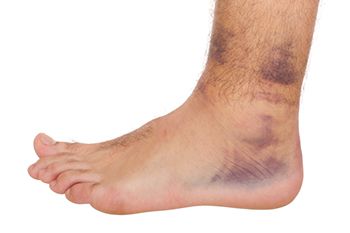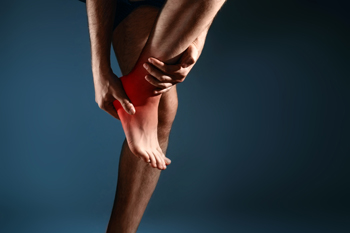Connect With Us
Blog
Items filtered by date: August 2022
Several Reasons for Poor Circulation in the Feet

Poor circulation in the feet is common among diabetic patients. Acrocyanosis, which is a condition that can affect the extremities, and arteriosclerosis which can be triggered by high blood pressure are other reasons why this condition can develop. Poor circulation in the feet is the result of closed or narrow blood vessels, and patients who have this may be at risk for other health issues. Some of the symptoms that are associated with this condition include hair loss on the feet and legs, and dry or cracked skin. Additionally, people who have poor circulation may have weak toenails, and their feet may feel cold and have a bluish tint. The medical condition known as Raynaud’s disease syndrome may cause the blood vessels in the feet to become narrow, and this can limit the amount of blood that circulates. Additionally, peripheral artery disease (PAD) may contribute to poor circulation. This can cause the inability to feel existing cuts and scrapes that may have developed on the feet as a result of excessive plaque build up in the arteries. If you have poor circulation in your feet for any reason, please contact a podiatrist who can properly diagnose and treat this ailment.
Poor circulation is a serious condition and needs immediate medical attention. If you have any concerns with poor circulation in your feet contact one of our podiatrists of Southwest Podiatry. Our doctors will treat your foot and ankle needs.
Poor Circulation in the Feet
Poor blood circulation in the feet and legs is can be caused by peripheral artery disease (PAD), which is the result of a buildup of plaque in the arteries.
Plaque buildup or atherosclerosis results from excess calcium and cholesterol in the bloodstream. This can restrict the amount of blood which can flow through the arteries. Poor blood circulation in the feet and legs are sometimes caused by inflammation in the blood vessels, known as vasculitis.
Causes
Lack of oxygen and oxygen from poor blood circulation restricts muscle growth and development. It can also cause:
- Muscle pain, stiffness, or weakness
- Numbness or cramping in the legs
- Skin discoloration
- Slower nail & hair growth
- Erectile dysfunction
Those who have diabetes or smoke are at greatest risk for poor circulation, as are those who are over 50. If you have poor circulation in the feet and legs it may be caused by PAD and is important to make changes to your lifestyle in order to reduce risk of getting a heart attack or stroke. Exercise and maintaining a healthy lifestyle will dramatically improve conditions.
As always, see a podiatrist as he or she will assist in finding a regimen that suits you. A podiatrist can also prescribe you any needed medication.
If you have any questions please feel free to contact our offices located in Dallas, and Carrollton, TX . We offer the newest diagnostic and treatment technologies for all your foot and ankle needs.
Are Bunions Affecting Your Everyday Life?
Possible Causes of Cracked Heels

Having dry, cracked skin on your feet can interfere with your plans to wear beautiful, strappy sandals to your evening event. Cracked feet are not just unsightly though, deep fissures and cracks can make walking and standing painful, sometimes unbearable. Furthermore, germs can enter these breaks in the skin and cause infections. There are different things that can cause cracked heels. Dry skin is commonly the culprit of cracks in heels and occurs because the skin loses too much oil and water. This condition often shows up in dry, cold weather. The use of furnaces and air conditioners, bathing in hot water, using harsh soaps, aging, having skin disorders like psoriasis and eczema, or physical conditions, like hyperthyroidism or diabetes, can all contribute to dry skin. Another reason for cracked heels might be putting excessive pressure on your feet. This can include prolonged standing, being overweight, and wearing shoes that have open backs and do not protect the pad of the fat under the feet. The feet expand toward the sides, which can result in splitting of hard, dry skin there. Athlete’s foot is a fungal infection that affects the feet. It thrives in moist, warm areas and the feet are a perfect host for this. This condition can cause peeling, flaking, and cracked skin on the sides of the feet and between your toes. If there is an infection, symptoms can worsen to stinging, burning, blisters, red skin, and itching. Spending too much time in the sun and getting sunburnt can be yet another reason for dry, cracked heels. Washing and drying your feet well, using moisturizer daily, wearing shoes made of material that breathes and that fit properly, controlling excessive sweating, and tending to secondary conditions may all help. If you are not able to keep your dry, cracked heels under control, or if signs of infection are present, consult with a podiatrist who can help you with treatment options that have a greater chance of controlling this annoying condition.
Cracked heels are unsightly and can cause further damage to your shoes and feet. If you have any concerns, contact one of our podiatrists from Southwest Podiatry. Our doctors can provide the care you need to keep you pain-free and on your feet.
Cracked Heels
Cracked heels appear unappealing and can make it harder for you walk around in sandals. Aside from looking unpleasant, cracked heels can also tear stockings, socks, and wear out your shoes. There are several methods to help restore a cracked heel and prevent further damage.
How Do You Get Them?
Dry skin is the number one culprit in creating cracked heels. Many athletes, walkers, joggers, and even swimmers suffer from cracked heels. Age and skin oil production play a role to getting cracked heels as well.
Promote Healing
Over the counter medicines can help, especially for those that need instant relief or who suffer from chronic dry feet.
Wear Socks – Wearing socks with medicated creams helps lock in moisture.
Moisturizers – Applying both day and night will help alleviate dryness which causes cracking.
Pumice Stones – These exfoliate and remove dead skin, which allows for smoother moisturizer application and better absorption into the skin.
Change in Diet
Eating healthy with a well-balanced diet will give the skin a fresh and radiant look. Your body responds to the kinds of food you ingest. Omega-3 fatty acids and zinc supplements can also revitalize skin tissue.
Most importantly, seek professional help if unsure how to proceed in treating cracked heels. A podiatrist will help you with any questions or information needed.
If you have any questions, please feel free to contact our offices located in Dallas, and Carrollton, TX . We offer the newest diagnostic and treatment technologies for all your foot care needs.
Facts About Sprained Ankles

Most sprained ankles occur when the ankle rolls outward as the foot twists inward. This causes the ligaments on the outside of the ankle to stretch and possibly tear. With a mild sprain, the ankle may be sore and stiff. It may swell slightly, but you should be able to walk with minor pain. As the severity of the sprain increases, your ankle may become bruised and tender, making walking far more painful. With a severe sprain, the ankle joint will feel unstable, and bearing weight is not possible. Ankle sprains can take a while to heal, but this long process is important to avoid re-spraining the ankle or developing chronic ankle problems. If you hear a popping sound at the time of the sprain, please see a podiatrist immediately. You will undergo an exam and be given a treatment schedule that may include pain medication, exercises, or bracing to protect the joint and allow it to heal properly. In some cases surgery may be required.
Although ankle sprains are common, they aren’t always minor injuries. If you need your ankle injury looked at, contact one of our podiatrists from Southwest Podiatry. Our doctors can provide the care you need to keep you pain-free and on your feet.
How Does an Ankle Sprain Occur?
Ankle sprains are the result of a tear in the ligaments within the ankle. These injuries may happen when you make a rapid shifting movement while your foot is planted. A less common way to sprain your ankle is when your ankle rolls inward while your foot turns outward.
What Are the Symptoms?
- Pain at the sight of the tear
- Bruising/Swelling
- Ankle area is tender to touch
- In severe cases, may hear/feel something tear
- Skin discoloration
Preventing a Sprain
- Wearing appropriate shoes for the occasion
- Stretching before exercises and sports
- Knowing your limits
Treatment of a Sprain
In many cases, the RICE method (Rest, Ice, Compression, and Elevate) is used to treat ankle sprains. However, you should see a podiatrist to see which treatment option would work best with your injury. In severe cases, surgery may be required.
It is important to ask your doctor about rehab options after you receive treatment for your injury. Stretching, strength training, and balance exercises may help the ankle heal while also preventing further injury.
If you have any questions, please feel free to contact our offices located in Dallas, and Carrollton, TX . We offer the newest diagnostic and treatment technologies for all your foot care needs.
Many People Experience Foot Pain

Many people experience foot pain at some point in their lives. Research has indicated that approximately 75,000 miles have been walked by the age of 50, and the likelihood is high that foot pain can develop. A common foot condition is athlete’s foot, and this is contagious. It is caused by a fungus that lives and thrives in warm and moist environments including shower room floors, public swimming pools, and locker rooms. Blisters can be quite uncomfortable and may develop from wearing shoes that do not fit correctly. A bunion is defined as a bony lump on the side of the big toe and is considered to be a deformity. Bunions can occur as a result of genetic factors or from wearing shoes that do not have adequate room for the toes to move freely. If the bunion is severe, surgery may be required for permanent removal. Another popular ailment is heel pain, which is most frequently caused by plantar fasciitis. Children can also develop heel pain known as Sever’s disease. Gout is said to be more prevalent among men and typically results from having excess uric acid in the blood. This causes crystals to form in the joints of the big toe and can cause debilitating pain. If you have any foot pain, it is strongly advised that you are under the care of a podiatrist who can properly diagnose and treat your condition.
Foot Pain
Foot pain can be extremely painful and debilitating. If you have a foot pain, consult with one of our podiatrists from Southwest Podiatry. Our doctors will assess your condition and provide you with quality foot and ankle treatment.
Causes
Foot pain is a very broad condition that could be caused by one or more ailments. The most common include:
- Bunions
- Hammertoes
- Plantar Fasciitis
- Bone Spurs
- Corns
- Tarsal Tunnel Syndrome
- Ingrown Toenails
- Arthritis (such as Gout, Rheumatoid, and Osteoarthritis)
- Flat Feet
- Injury (from stress fractures, broken toe, foot, ankle, Achilles tendon ruptures, and sprains)
- And more
Diagnosis
To figure out the cause of foot pain, podiatrists utilize several different methods. This can range from simple visual inspections and sensation tests to X-rays and MRI scans. Prior medical history, family medical history, and any recent physical traumatic events will all be taken into consideration for a proper diagnosis.
Treatment
Treatment depends upon the cause of the foot pain. Whether it is resting, staying off the foot, or having surgery; podiatrists have a number of treatment options available for foot pain.
If you have any questions, please feel free to contact our offices located in Dallas, and Carrollton, TX . We offer the newest diagnostic and treatment technologies for all your foot care needs.
When Sports Footwear Causes Pain on the Top of the Foot

There are thin tendons on the top of your feet that connect your toes with muscles in the front of the lower leg. These are called extensor tendons. Extensor tendons help you flex your feet and raise your toes. Because they reside just underneath the skin on the top of the feet and have no padding, they are susceptible to becoming injured, inflamed, and painful. This is known as extensor tendonitis. Extensor tendonitis can sometimes be caused by overuse, or from shoes that are too tight. Dancers, runners, skiers, and skaters are susceptible to developing extensor tendonitis because they wear shoes that lace tightly in the front which can press hard against these tendons. In this way, extensor tendonitis is sometimes a sports-related injury. Extensor tendonitis can be diagnosed and treated by a podiatrist who may need to analyze imaging tests to rule out other injuries and make sure no other damage has been done to surrounding structures. It is suggested you consult with your podiatrist for shoe modifications, stretching, and strengthening exercises, and they may prescribe anti-inflammatory drugs, suggest icing, or even prescribe steroid therapy. In very severe cases, surgery may be necessary to repair the extensor tendons.
Ankle and foot injuries are common among athletes and in many sports. They can be caused by several problems and may be potentially serious. If you are feeling pain or think you were injured in a sporting event or when exercising, consult with one of our podiatrists from Southwest Podiatry. Our doctors will assess your condition and provide you with quality foot and ankle treatment.
Common Injuries
The most common injuries that occur in sporting activities include:
- Achilles Tendonitis
- Achilles Tendon Rupture
- Ankle Sprains
- Broken Foot
- Plantar Fasciitis
- Stress Fractures
- Turf Toe
Symptoms
Symptoms vary depending upon the injury and in some cases, there may be no symptoms at all. However, in most cases, some form of symptom is experienced. Pain, aching, burning, bruising, tenderness, tightness or stiffness, sensation loss, difficulty moving, and swelling are the most common symptoms.
Treatment
Just as symptoms vary depending upon the injury, so do treatment options. A common treatment method is known as the RICE method. This method involves rest, applying ice, compression and elevating the afflicted foot or ankle. If the injury appears to be more serious, surgery might be required, such as arthroscopic or reconstructive surgery. Lastly, rehabilitation or therapy might be needed to gain full functionality in the afflicted area. Any discomfort experienced by an athlete must be evaluated by a licensed, reputable medical professional.
If you have any questions, please feel free to contact our offices located in Dallas, and Carrollton, TX . We offer the newest diagnostic and treatment technologies for all your foot care needs.

